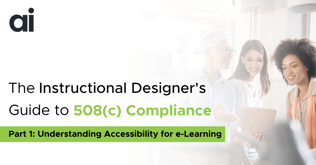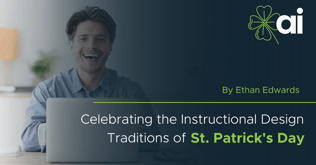Blog
508(c) Compliance Guide For Instructional Designers - Part 2: Can Compliant ...
Read Part One of Series | Read Part Two of Series

.png?width=1387&height=526&name=Services%20-%20Custom%20Learning%20-%20%20508c%20Blog%20Series%20Headers%20(7).png)
508(c) Compliance Guide for Instructional Designers - Part 3: 7 Easy Steps to Compliant e-Learning Experiences
By Ethan Edwards | May 05, 2022 | Custom Learning | 0 Comments
Read Part One of Series | Read Part Two of Series
Where do we go from here?
As I've mentioned, I'm far from having solved this challenge, but I do know that if we are in the business of training, we can't justify creating training that falls so short of being effective simply because we are also striving for the very positive goal of accessibility.
There are some common techniques that accessibility design relies on and are supported by most current authoring systems. These efforts will create pieces that are minimally accessible for just about anyone. What is noteworthy, though, is that while these strategies consider the mechanics of access, they are completely independent of the requirements of learning.
But here are some ideas that motivate me to find creative and powerful ways to achieve e-learning that makes a difference to every learner:
- Accessibility doesn't require a one-for-all solution.
The idea that we must create a single lesson that works identically for everyone is perhaps desirable for efficiency in authoring and maintenance, but accessibility rules do not require it. In fact, the regulation explicitly recognizes the use of alternative design or technology that results in substantially equivalent or greater accessibility by individuals with disabilities than would be provided by conformance to the core requirements. - Pointless interactivity is often less useful than no interactivity at all.
If budget and timelines urge you to implement tedious training (often attributed to the need to be 508-compliant) consider ways to create richly accessible information sites and don’t pretend that the trivial interactivity of overly simplistic e-learning is of value. It is far more effective to create a compelling information delivery piece that is universally accessible and meaningful than to create an “interactive” e-learning module that neither teaches nor engages. - Being user-centered applies to learners with disabilities, too.
When designing for these populations, we need to put ourselves in their shoes. A person without sight experiences the world differently than those with sight. We should think about the most supportive way for a sight-impaired learner to engage and explore new content. Most e-learning is designed and sequenced relying on visual information processing patterns. The accessibility issues are too often incorporated after the fact in the most superficial of ways (e.g., adding alt text tags to images) without considering whether this is helpful. Instead of a disjointed message that the learner must cobble together based on the hard-to-predict behavior of a screen reader, a coherent narrative that is not built around and tied to images could be much more impactful to the learner. - Don’t abandon the idea of elevated “Activity” within CCAF design simply because of some blanket rejection of Drag and Drop.
You can still create very compelling immersive activities with some slight adjustments. For example, the following steps can be used as a strategy to increase accessibility for a drag and drop type interaction. - Break e-learning interactions into steps.
Provide alt text descriptors to identify the draggable objects while using keyboard controls to first select the object to move. Then shift to the second stage of the interaction where the learner selects the destination. Next, use animation capabilities to move the object to the selected target. Make the objects and targets large enough and this is a satisfying action-based interaction appealing to users using a mouse or using key entry. - Use selective branching to provide alternative access at points that matter.
That design is a mainly uniform experience that provides alternative paths at critical points where interactivity or media needs to change significantly. - Consult with members of the communities you are designing for.
As a fully sighted person, I can’t begin to understand how to design an experience for the visually impaired without asking and seeking understanding. Without that, we just perpetuate stereotypes and misguided strategies.
Does it matter?
This is the hardest part of this challenge. I imagine this might seem to be a controversial aspect of the topic, but the first decision you and your organization need to make is “Do we care?” I mean, that is a serious question for which one might reasonably answer Yes or No—perhaps with a different answer depending on the situation. From that, it becomes a question of how much you care - or how you are invested in universal training for your learners. Are you concerned about compliance because your commonly-held company values inspire you to provide the right access to every person? Do your company values drive you toward accessible solutions, but do you know that there are currently no potential learners with disabilities in your current target population and the shelf-life of a current project is only a matter of a few months? Is no one concerned with or monitoring the quality of your work and the only concern is that it is technically 508 compliant? There are many, many variations of these questions, and unfortunately, no perfect answer.
Driving accessibility standards in your organization
I believe that operating under the principle of “we’re only doing this because we have to” is a weak rationale in the long run. But if that is the feeling that is driving design decisions that create training that is compliant only to the letter of the law rather than the spirit of the law, the problem is not in your authoring tools or delivery platform, but rather in a clear vision within your training department.
I doubt many training departments could survive with an overtly stated mission, “When it comes to providing universal access, our only interest is to satisfy the minimum acceptable technical standards without regard to outcome.” Yet, it seems too often that is the philosophy that guides the development of e-learning. Perhaps the most pressing thing to be done is for each design group to develop and articulate a statement of shared purpose and responsibility regarding your commitment to providing accessible products—not just because the law requires it—but because roles as educators demand it.
Advocates for accessibility
Training is nothing if it isn’t about eliciting positive change in the learner population. As trainers, we have a huge responsibility in being leaders of that change, and a primary aspect of that role is to be champions and advocates for the learner—that is, every learner, regardless of the individual and diverse challenges each brings to the learning experience. It is especially important to bear this at the forefront of our design activities when responding to the specific requirements of 508 compliance standards. To succeed, it requires somewhat more than selecting the “Make Accessible” option before publishing a module. What will your response be?
It is relatively straightforward to design for accessibility if we don’t care about instruction. But designing accessible courseware that is equally effective for all potential learners is extremely difficult and time-consuming. How your organization chooses to design for accessibility effectively boils down to the degree to which your organization views these projects as a true learning priority or more simply as something to provide as some sort of placeholder for actual training that creates performance change. I don’t mean this superficially or cynically. Truly, each project undertaken has a perceived value to the organization and the learners, and we invest in each to the extent its needs are valued.
It troubles me, though, that in the realm of 508 Compliance, the commitment is so low. I have never been in an initial design session with a client where the discussion centered on “How can we design an experience that will be the best possible learning experience for each learner” rather than “Remember we have to somehow make it, at best, at least navigable by each learner.” This isn’t a question of capability or technology, but rather an expression of values.
Final thoughts
Truthfully, three blogs will never be enough to encompass the entire conversation about accessibility, compliance, and creating universal learning solutions that create exceptional learning experiences for all learners--but we have to begin the conversation and outline the considerations, audiences, and needs of our learners in order to promote human performance in our organizations. Being able to educate ourselves on the needs of our learners not only allows us to better understand our audiences, but also to envision what performance change truly looks like in our organization so that we may create Meaningful, Memorable, and Motivational learning experiences for everyone--not just our core teams.

About the Author: Ethan Edwards
Ethan Edwards draws from more than 30 years of industry experience as an elearning instructional designer and developer. He is responsible for the delivery of the internal and external training and communications that reflect Allen Interactions’ unique perspective on creating Meaningful, Memorable, and Motivational learning solutions backed by the best instructional design and latest technologies.
Comments
Would you like to leave a comment?
Related Blog Posts
.png?width=316&name=Services%20-%20Custom%20Learning%20-%20%20508c%20Blog%20Series%20Headers%20(6).png)
By: Ethan Edwards | Apr, 2022
Category: Custom Learning

Blog
508(c) Compliance Guide for Instructional Designers - Part 1: Understanding ...
Read Part One of Series | Read Part Two of Series
By: Ethan Edwards | Apr, 2022
Category: Custom Learning

Blog
Celebrating the Instructional Design Traditions of St. Patrick's Day
Read Part One of Series | Read Part Two of Series
By: Ethan Edwards | Mar, 2022
Category: Custom Learning

